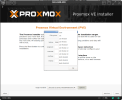Good Morning,
I'm also new to Proxmox. We have 9 HPe Gen11 servers with four 6.4tb SSD drives for each server for a total of roughly 24tb of local space per server. We are going to setup a cluster with Ceph and will let Ceph manage the storage.
The question I have is do I put any kind of RAID when I initially setup a Proxmox VE node or do I add the disks after installation? Also, do I use any RAID on the disks or use ext4 or xfs or any of the zfs raid options? I understand there are alot of different variables, etc. but is there possibly a standard way of setting up each node using Ceph?
The Proxmox environment is not in production yet and I only have 3 of the servers currently set up with Proxmox VE and I was about the create the cluster but losing 1/2 of the drive space by selecting zfs RAID10 may not be the best option if I'm going to use Ceph to manage the storage.
Any insight into this would be greatly appreciated.
Thank you in advance for assistance with this issue.
Brian
I'm also new to Proxmox. We have 9 HPe Gen11 servers with four 6.4tb SSD drives for each server for a total of roughly 24tb of local space per server. We are going to setup a cluster with Ceph and will let Ceph manage the storage.
The question I have is do I put any kind of RAID when I initially setup a Proxmox VE node or do I add the disks after installation? Also, do I use any RAID on the disks or use ext4 or xfs or any of the zfs raid options? I understand there are alot of different variables, etc. but is there possibly a standard way of setting up each node using Ceph?
The Proxmox environment is not in production yet and I only have 3 of the servers currently set up with Proxmox VE and I was about the create the cluster but losing 1/2 of the drive space by selecting zfs RAID10 may not be the best option if I'm going to use Ceph to manage the storage.
Any insight into this would be greatly appreciated.
Thank you in advance for assistance with this issue.
Brian


